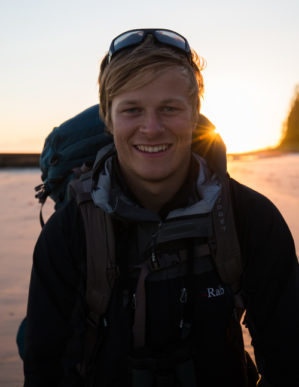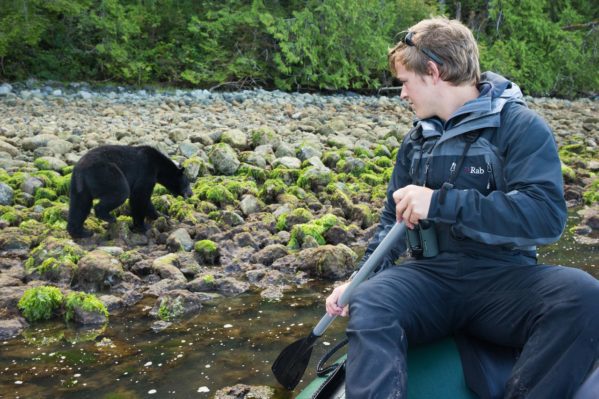INTERVIEW: Bertie Gregory heads to Vancouver Island on new Nat Geo Wild web series

Nat Geo Wild, the wildly successful television channel, has ventured away from people’s living rooms and onto their iPads, iPhones and laptops. The network recently premiered wild_life With Bertie Gregory, a new nature-based series that follows the 22-year-old filmmaker as he ventures to tucked-away Vancouver Island in search of some megafauna.
The web series, which premieres new episodes every Wednesday, finds Gregory scuba diving, boating and hiking to film everything from black bears to steller sea lions to American bald eagles. One of the most elusive animals he searches for is the coastal wolf, a canid that grabs most of its diet from the ocean. Whether or not he captures footage of these majestic and unique creatures remains to be seen.
“So, it all started back in 2011 when I went out to the west coast of Vancouver Island, where the series is based, and I completely fell in love with the landscape,” Gregory said recently in a Skype interview. “There’s this rainforest-connected mountain range that juts right up against the ocean, and it’s the Pacific Ocean, the west coast of Canada. So it’s just hammered by waves. Really epic landscape, and within that landscape it’s just ram-packed full of loads of big, sexy, charismatic predators.”
During that 2011 trip, a wildlife tour guide showed Gregory a thing or two about finding the different animals and how to approach them for the best photographic shots. The one animal he was most impressed with was the coastal wolf.
“When I think of wolves I think of snow-capped mountains, Yellowstone National Park,” he said. “These wolves are totally different. They live on the beach, and up to 90 percent of their diet comes from the ocean. So they eat barnacles, mussels, fish, whales. … When I was there, I got to know this one female wolf. She was the leader of her pack, the alpha female, and about six months after I came back home to England, where I live, I was sent a message basically saying that she had been shot and thrown into a local fishing village dumpster. And if she was called Cecil, if she was a lion, people would have cared, but she’s a coastal wolf. And people don’t know about coastal wolves, so nothing happened. So I kind of ever since then have been thinking how I can return, how I can show coastal wolves to the world, get people to fall in love with them and the landscape in which she lives, and this opportunity came about with National Geographic.”
Gregory received a Zenith Explorer Award from the Scientific Exploration Society based in the United Kingdom, and the funds helped him with his aspirations to film the coastal wolf. What he needed was a proper media outlet for his hopeful footage. That’s when National Geographic entered the picture.
“I pitched a television program, and they said, ‘Well, it was a bit of a risk,'” he remembers them saying because of his lack of a TV audience at that stage. “And then they were saying, ‘Well, we like to do digital stuff,’ and I jumped at the opportunity to do online stuff because I think that’s the future. It’s becoming more and more important, and yeah it was cool that it was going to be Nat Geo Wild’s first-ever digital series. So I thought that is a pretty cool thing to do.”
Gregory’s goal with the project, which so far has racked up tens of thousands of hits on YouTube, is to amass an audience of both regular TV viewers and newcomers, such as the younger demographic, that might not watch traditional programming. “These people are full of some of the most important people because in 10-20 years time they are going to be deciding the fate of our planet,” he said. “I want them to be interested in wildlife because I think that’s going to help wildlife, and it’s going to help us as well.”

When filming the animals on Vancouver Island, Gregory went about the project much like any other Nat Geo filmmaker. He wanted those epic shots of pure nature, and it’s hard to argue with his results. Episode two of wild_life, for example, shows in stunning close-up action a black bear flipping over rocks to search for crabs. The bruin, a young male, turns over the exposed rocks, some of them weighing 350 pounds, like they were pebbles in a garden. Gregory then descends upon the beach, after the bear has left, and tries some rock-lifting himself. He soon appreciates how strong this black bear was in its search for crabs.
When the camera is not turned on the animals, Gregory takes a more relaxed, online-friendly approach. For example, there are times when he speaks to the camera almost in selfie fashion, and he keeps the narrative fast-paced and intimate. Episodes run only 5 minutes.
One logical question might be if Gregory actually finds more coastal wolves, like his first trip in 2011. He was tight-lipped about his discoveries, but he did emphasize that the elusive nature of these animals doesn’t mean success is guaranteed.
“You’ll have to wait and see as to whether or not I find the coastal wolves,” he said. “This project was without a doubt the hardest thing I’ve ever done. Having had experience filming coastal wolves back in 2011, I went into this project very confident that I could deliver. It turned out that it was just on another level of difficult. … In Yellowstone, you spend a week there in winter, you’re going to see them. These wolves are just, the lengths that you have to go to to even see a footprint is just ridiculous. They’re crazy elusive, and as I said, it was really, really difficult. So I think assuming that I find wolves would be short-sighted, shall we say. You’ll have to wait and see, I guess.”
One of Gregory’s highlights from wild_life was when he had the chance to swim with steller sea lions. These aquatic animals can measure up to 12 feet and weigh 2,000 pounds. Their skull, Gregory said, is similar to that of a grizzly bear. With such large features come large teeth. On land, they look like big blobs of blubber, as the filmmaker put it, but in the ocean they are different beasts.
“They suddenly lengthen out, and they become this long, sleek, sexy, athletic animal,” he said. “So we got into the water with them, and it turns out they are pretty curious. And they bite a lot, not aggressively as you see in the episode. It’s more they’re curious. So they don’t have hands, so if they want to feel what a new funky object feels like, they’ve got to use their teeth. So they bite you, which initially might sound incredibly scary, and it was a little nerve-wracking to start with, but yeah it was just awesome to have such a close encounter with an animal and give it a scratch on the chin. When else do you get to give a wild animal that weighs 2,000 pounds and is 11 feet long? When else do you get give it a little tickle on the chin, and he enjoys it?”
For those viewers who want to take a similar trip, Vancouver Island proves to be an accessible area in western Canada. Gregory was based out of a fishing town on the west coast where there are modern amenities like restaurants, hotels and places to surf. However, head 10 minutes in either direction, and the tourist area is substituted for sheer wildness.
“What I hope this series does is not only get people excited about the wildlife on the west coast of Canada,” he said. “I just want people more excited about wildlife in general. I want the person who’s in 10th grade at school, is obsessed with birds, to be the cool kid, not the geek. That’s what I want. I want people to get off their iPads and their iPhones, and to get outside and get up close and personal with nature because it’s good for your soul, and everyone needs it. And there’s wildlife anywhere. It doesn’t matter where you live, even in a city. I’ve photographed tons of wildlife in cities. You just got to look hard enough, so it doesn’t matter where you live. There’s wildlife to go and find.”
When growing up, Gregory’s family was obsessed with water sports, and when he was bobbing up and down on a surfboard in the waters off southwest England, he would take in the nature around him. He became a “total freak” for wildlife, and that passion has stayed with him.
He remembers stealing his father’s camera and going off to photograph wildlife. “I was curious, so I started stealing it,” he said. “And I taught myself to use it. I realized that by taking pictures and videos of the animals that I saw, not only was it a great way for me to channel my obsession, my passion to try and get the shot, but also it was cool to be able to share what I saw with other people. And it all kind of evolved from there. I just got so obsessed with wildlife and documenting it that I couldn’t think of anything else that I would be able to do because I’ve always just been so focused on doing that.”
By John Soltes / Publisher / John@HollywoodSoapbox.com
Click here for episodes of wild_life With Bertie Gregory. On the horizon, fans take note: Gregory is in Brazil on a special National Geographic project involving jaguars.

